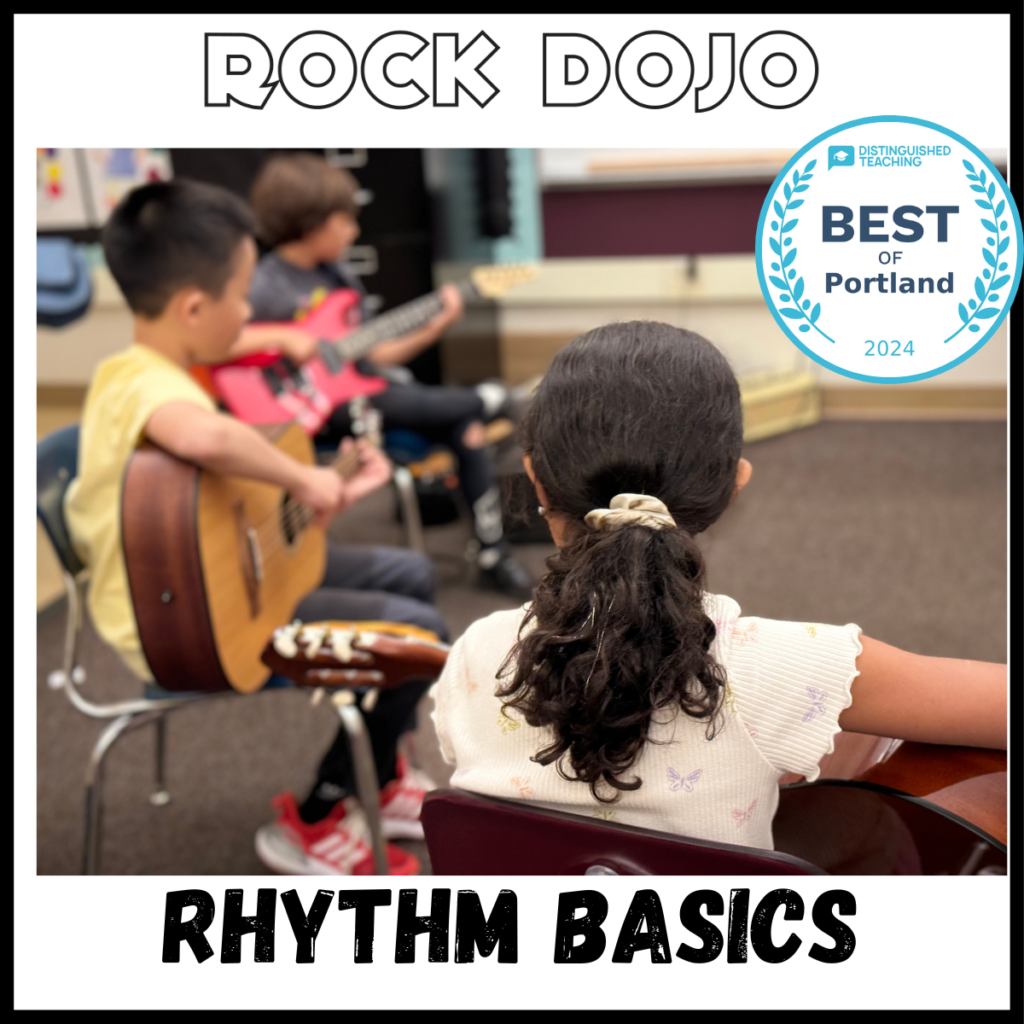
Rhythm in music is one of the most essential skills a young musician can develop. At Rock Dojo, we focus on rhythm from day one because it’s the foundation of music and the secret to transforming notes into a compelling performance. This quarter at Rock Dojo’s award-winning after-school guitar program, we’ve been teaching our students the basics of rhythm – quarter notes, eighth notes, half notes, whole notes, and rests – and now we’d like to share these concepts with you!
What is Rhythm in Music?
Rhythm is the timing of sounds in music – the steady beat that keeps everything in sync. Just like a heartbeat keeps us alive, rhythm keeps music alive. Think of it as the pulse of a song, guiding every note and creating the energy that drives the music forward.
Basic Rhythmic Units
To understand rhythm, let’s look at some basic units of rhythm. These are the building blocks that your child has been learning in their Rock Dojo classes:
- Whole Notes (
 ): Whole notes are the longest, spanning four beats. They add moments of calm and give space to music.
): Whole notes are the longest, spanning four beats. They add moments of calm and give space to music. - Half Notes (
 ): Half notes are longer, taking up two beats. They help create a slower, more flowing feeling in music.
): Half notes are longer, taking up two beats. They help create a slower, more flowing feeling in music. - Quarter Notes (♩): Quarter notes are often called “one beat notes.” If you’re tapping your foot to a steady beat, each tap represents a quarter note.
- Eighth Notes (♪): Eighth notes are faster, dividing each beat into two equal parts. Think of these as the “and” in “one-and-two-and-three-and-four.”
- Rests: Rests are silent beats, just as important as notes. They create breaks and structure the rhythm, adding depth and dynamic contrast.
Why Rhythm in Music Matters
So, why do we place so much emphasis on rhythm at Rock Dojo? Here are some reasons why rhythm is the cornerstone of music education:
- The Backbone of Music: Music would be a jumble of random sounds without rhythm. Rhythm holds everything together, ensuring that all the musicians in a band play in sync. It’s what makes music sound organized and complete.
- Improves Coordination and Focus: Learning to play rhythmically demands coordination and concentration, especially for young learners. Rhythm exercises help kids develop timing, balance, and a strong sense of musical structure.
- Essential for Ensemble Playing: Rhythm is necessary when playing with others. A solid sense of rhythm allows musicians to play together smoothly, creating that magical feeling when all the parts blend perfectly.
- Boosts Musical Expression: Rhythm gives music its energy and emotion. Musicians can make a song feel upbeat and lively or slow and contemplative through rhythm. It’s a vital part of self-expression, allowing kids to connect with and convey the music’s mood.
- The Gateway to Advanced Skills: Mastering rhythm provides a foundation for more advanced musical skills, like improvisation and composition. Once a child has a strong sense of rhythm, they’re better prepared to explore complex musical concepts in the future.
How You Can Support Your Child’s Rhythm Learning
Want to help your child build a strong sense of rhythm in music? Here are some fun ways to support their rhythm education at home:
- Clap Along to Music: Clap along with the beat of a favorite song. Ask your child to identify the quarter notes, eighth notes, and rests. It’s a simple but powerful way to reinforce rhythm.
- Use a Metronome: Practicing with a metronome helps students stay on beat. Try setting it to a slower tempo and gradually increasing the speed to challenge your child.
- Dance Together: Dance is a fun, physical way to feel the rhythm. Put on some music and dance with your child, encouraging them to move in time with the beat.
- Rhythm Games: Create a game where you tap out a rhythm, and your child has to copy it. It’s a great way to make rhythm practice feel like a game.
Rhythm is the foundation of all music, and with practice, it will become second nature for your child. At Rock Dojo, we’re committed to helping students develop a strong sense of rhythm and giving them the tools they need to succeed in music and beyond. Thank you for supporting their musical journey!
Outside of Portland? No Problem!
Your child can still become a guitar hero with Rock Dojo’s Complete Series! Our award-winning program is designed to guide kids from beginner to guitar master, building confidence and igniting creativity. Be sure to connect with us on Facebook and Instagram for more updates!


